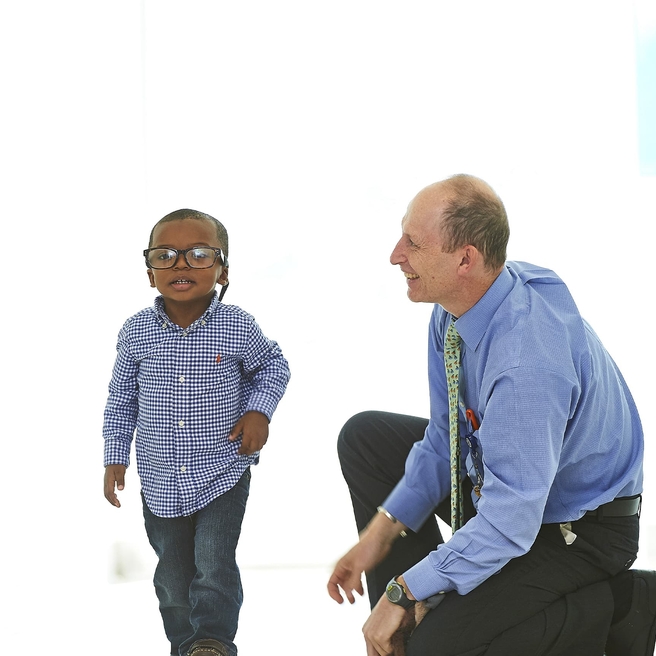What is thyroid eye disease?
Thyroid eye disease (also known as Graves’ eye disease, Graves’ ophthalmopathy or thyroid-associated ophthalmopathy) is an autoimmune inflammatory disorder of the soft tissues in the bony socket of the eye (orbit) associated with thyroid dysfunction. It is rare in children.
Thyroid eye disease can occur in all three thyroid states: hyperthyroid (overactive thyroid, the most common state), euthyroid, and hypothyroid (underactive thyroid).
Thyroid eye disease has several distinct phases:
- Active phase: Signs and symptoms of the disease flare up. The active phase of thyroid eye disease lasts about one year in nonsmokers, but can last up to two to three years in smokers.
- Stable phase: Inflammation has decreased, but the markers of the inflammation remain, including enlarged muscles and eye changes.
- Reactivation: Signs and symptoms of active disease return. This can occur in 5 to 10 percent of patients.
Signs and symptoms of thyroid eye disease
- Eyelid retraction (most common)
- Proptosis (the appearance that the eyes are bulging forward)
- Lagophthalmos (the eye does not close all the way)
- Lid lag on downgaze
- Restricted eye movements, which can lead to double vision
- Eyelid swelling
- Conjunctival infection (eye redness)
- Chemosis (swelling of the conjunctiva, the thin clear layer of tissue over the white part of the eye)
- Tearing from dryness that can lead to decompensation of the cornea (the front surface of the eye) from exposure
- Compressive optic neuropathy (compression of the optic nerve causing loss of color vision and loss of vision)
Risk factors
The number one risk factor for developing active thyroid eye disease is smoking — smokers are seven times more likely to be affected by thyroid eye disease. Women are six times more likely than men to be affected.
Other risk factors include uncontrolled thyroid disease and family history of thyroid eye disease.
Evaluation and diagnosis of thyroid eye disease
Thyroid eye disease is typically diagnosed based on medical history and presenting symptoms.
If a patient with some form of thyroid disease (such as hyperthyroidism or Graves’ disease, or hypothyroidism) experiences eye changes such as lid retraction, bulging eyes, redness, tearing, double vision, or loss of vision, their doctor may refer them to an ophthalmologist to be evaluated for thyroid eye disease.
Blood tests may be done to check thyroid levels. Imaging tests, such as a CT scan or MRI of the orbits, can be used to evaluate the extent of inflammation.
Treatment options for thyroid eye disease
The treatment for thyroid eye disease generally focuses on supportive care to manage the symptoms and control the disease. For more severe cases, steroids or surgery may be suggested.
During the active phase of thyroid eye disease, treatment for a mild to average case typically consists of regular observation with a focus on alleviating the symptoms. This may include lubrication of the eyes, sunglasses, cool compresses, a salt-restricted diet, and sleeping with the head elevated.
In more severe cases, oral steroids may be used to help decrease the inflammation. If the inflammation is severe enough to cause loss of vision or decompensation of the cornea, high-dose intravenous steroids and orbital radiotherapy may be used.
If the response is not adequate, urgent surgery may be performed to decompress the orbit and create more space for the enlarged muscles.
During the stable phase, surgery can be performed if needed to decompress the orbits and decrease the amount that the eyes bulge forward, repair eye muscle alignment for patients with double vision, and improve lid positioning.
If a patient smokes, it is strongly encouraged that they stop smoking, as it is the number one risk factor associated with thyroid eye disease.
Thyroid eye disease is rare in children, but when it does occur, our pediatric oculoplastic specialists monitor and manage these patients. When necessary, they perform orbital decompression and eyelid surgeries. We also have an eye muscle specialist who can correct alignment in both children and adults suffering from thyroid eye disease.
Resources to help
Division of Ophthalmology Resources
We have collected helpful resources on pediatric eye care so you can feel confident in the care you're providing your child.
